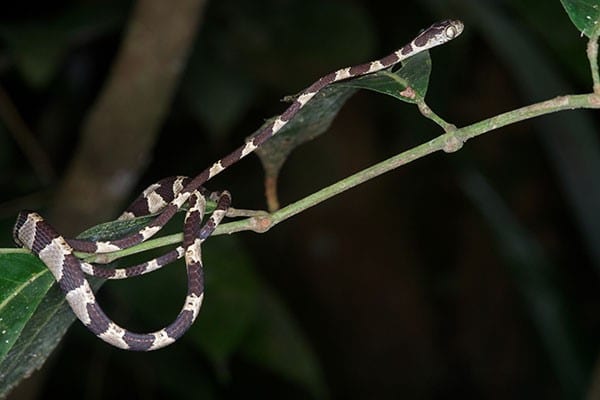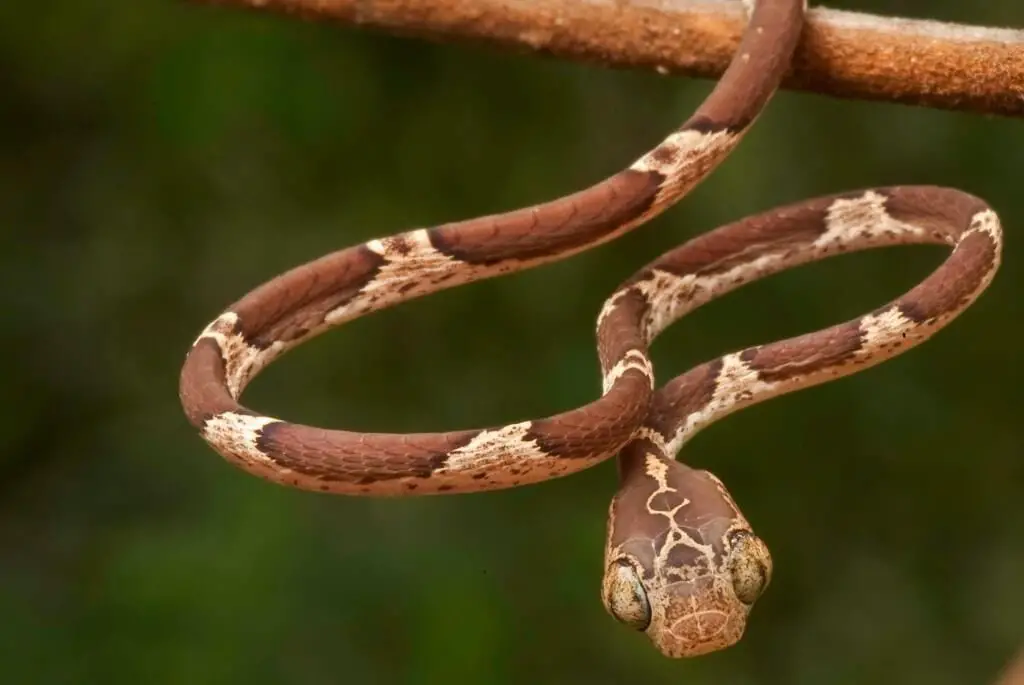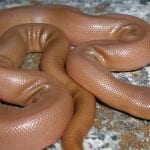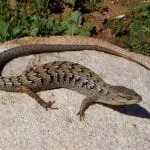Scientific Facts
| Common Name | Blunt-Headed Tree Snake, Fiddle-String Snake Mapepire Corde Violon |
| Scientific Name | Imantodes Cenchoa |
| Life Span | Unknown |
| Length | Average of 31.50 inches |
| Clutch Size | 2 to 3 eggs |
| Habitat | Wet forests and Rainforests |
| Country of Origin | Central America |
Physical Description

The Blunt-Headed Tree Snake is characterized by slim, long bodies, large heads, and very thin necks. They have eyes with vertical pupils. The eyes contribute to about 25% of their head length, protruding from one side. This distinct feature allows these snakes to look downward.
When measured from snout to vent, the length of these snakes reaches over 800 millimeters, though they can reach longer, up to 901 millimeters, with the overall body length often exceeding 1 meter. These snakes also have an adaptive and enlarged middorsal scale row, providing their bodies stability, especially when climbing.
These snakes are also primarily white in color ventrally and dorsally pale brown in hue. Their dorsal surface is often overlaid with about 29 to 56 blotches of dark brown color. The total number of blotches vary depending on the range of this species.
They also have rear fangs. Snakes living in the Northern range usually exhibit sexual dimorphism, with the male snakes featuring slightly longer tails. This is something unique to this range as the snakes from the South do not have these characteristics.
The size of the head of the Blunt-Headed Tree Snakes also helps in telling their sexes. Female snakes usually have greater head widths and lengths.
Etymology
The generic name of this species came from the Latin word “Immanis,” which means ‘enormous.’ Its suffix, on the other hand, “-odes,” which means ‘fullness, or likeness,’ which is most likely in reference to their size and the bulge of their eyes. Their specific name is possibly derived from the Greek word “kenchros,” which means ‘small grains,’ which may refer to the small lateral spots in their bodies.
Species
The genus in which Blunt-headed tree snakes belong, the Imantodes family consists of a number of species which are considered as native to South and North America, Central America, and Mexico.
There are eight currently recognized species of the Imantodes family. One of them is the Imantodes Cenchoa snake or the Blunt-headed tree snakes. Other species include Imantodes Chocoensis, or the Chocoan Blunt-headed vine snake, Imantodes Gemmistratus, Imantodes Guane, Imantodes Inornatus, or the plain-tree snake, Imantodes Lentiferus, Imantodes Phantasma, or the phantasma tree snake, and the Imantodes Tenuissimus.
Habitat
Blunt-Headed Tree Snakes thrive in primary and secondary growth forests, including plantation areas across wet and lowland moist forests. They are also found in premontane rainforests and wet forests, and lower rainforests and montane wet forests.
These snakes are generally observed as arboreal, which means that they are usually found in low vegetation such as bromeliads and coffee trees.
Geographic Range
Blunt-Headed Tree Snakes are generally found in Central America, specifically in Panama and Eastern Mexico, as well as the coastal areas of Western and Northern South America, particularly in countries including Brazil, French Guiana, Bolivia, Peru, Ecuador, Columbia, Venezuela, Argentina, Paraguay, as well as Trinidad and Tobago.
Lifespan
There is no information published regarding the average lifespan of Blunt-Headed Tree Snakes in the wild. It has been assumed that their longevity highly varies throughout their geographical range. This calls for the need to conduct further studies in relation to this species.
Behavior
Blunt-Headed Tree Snakes are arboreal and nocturnal snakes. At daytime, they may be observed as resting in a coiled position, usually in shaded bromeliads, which is one of their favorites. They can also be seen in leaf litter, at tree bases, and between coffee tree leaves. They have been observed to prefer resting in shaded places.
At night time, they also forage, usually from ground level up to 2 meters, in different varieties of dense vegetation, such as small trees, bushes, and vine tangles. Blunt-Headed Tree Snakes are usually active at night and have been observed to travel at an average of 5 to 10 meters in just 5 minutes on average.
Even though they are arboreal species, they love traveling across the forest floor. They are docile and love being solitary outside their breeding season. They are also not known to bite humans unintentionally. They are, however, quite deadly to their smaller prey.
Perception and Communication
Aside from observing some occasional male to male fights ,” may happen at mating, there is very little that known about interactions between individual snakes. They usually rely on their binocular vision offered by their protruding and vertically slit eyes to hunt successfully even at night. Just like all other snake species, Blunt-Headed Tree Snakes have outstanding tactile, olfactory, and hearing systems. These special capabilities allow them to hunt for food successfully and interact with other members of their community.
Development
Young Blunt-Headed Tree Snakes develop in eggs that are laid by female snakes. They are fed and nourished by yolk. The eggs usually reach 30.7 mm in length. When the juveniles hatch, they look like small adults. They usually lay eggs and hatch around the months of March to August, growing around 3.5 mm every week during their first two years. At this point, they will have also reached sexual maturity and is ready to reproduce.
Reproduction
Blunt-Headed Tree Snakes are described as polygynandrous reptiles. The seasons for mating may vary depending on the rainy season schedules in their habitat. There are some snakes that can mate all year round, while some observe a mating season that is synced with the rainy and wet seasons in their environment.
Mating of Blunt-Headed Tree Snakes may happen throughout the year, even though the mating season usually happens during the rainy seasons in certain areas. In regions with longer rainy seasons, snakes tend to produce longer, while in areas with shorter rainy seasons, more rapid development and reproduction are required.
These snakes are oviparous, which means that female snakes lay eggs. There is a minimum of zero embryonic development within the mother snake. An average clutch contains 2 to 3 eggs, with the clutch size varying depending on different factors, including habitat, female body size, and feeding habits. Female snakes usually reach sexual maturity when they reach a length of around 620 mm, while males also mature around the same size. They usually reach these lengths at around 2 to 3 years after hatching.
In some instances, male to male snake fighting related to mating has been observed among Blunt-Headed Tree Snakes, both in the Peruvian rainforest and Brazilian Amazon. This is notable since no other recorded male to male fighting has been reported for other species within this family.
One record of this behavior observed a male of a mating pair attacking another nearby male, using his anterior part of the body to force away from the potential rival. These snakes generally show continuous reproduction. In regions with seasonal rainfall, however, laying of eggs and hatching is observed to positively correlate with the local wet seasons.
For instance, in Mexico and Guatemala, eggs are usually laid between June and July, with the hatchlings starting to appear in July and August, corresponding with the schedule of wet seasons in these countries. In the rainforests in Brazil, for example, continuous reproduction is observed, and yolk production (Vitellogenesis) usually happens from September through December, with the eggs laid between November and January, and the hatchlings starting to appear from March to August.
There is no current study showing the care that parent snakes give their young. Brooding is not common in all snake species aside from those that belong in the Pythonidae family. Thus, it is an assumption that because the Blunt-Headed Tree Snakes are oviparous, females usually leave their eggs right after laying them, and both parents do not look after their hatchlings. The hatchlings, on the other hand, are born capable of protecting and caring for themselves.
Feeding and Habits

Blunt-Headed Tree Snakes usually forage for food at night, eating small arboreal lizards, especially those that belong in the anoles family. Aside from eating small lizards, they are also known to target adult frogs as well as reptile eggs.
Female snakes from Panama are also known to consume bigger prey, thanks to their larger heads. This results in a difference in feeding trends, not just regionally, but also between males and females. Female snakes are also known to eat larger frogs and other amphibians, thanks to their bigger size.
Roles in the Ecosystem
Blunt-Headed Tree Snakes are the primary predators of Anolis lizards. Even though there has been no information available regarding the main predators of this species, it is most likely a source for food of different species of birds of prey.
Predation
Despite the lack of information regarding specific predators of this species, the main predators of other snakes include birds of prey, including laughing falcons and crane hawks. To help them avoid predation, Blunt-Headed Tree Snakes hide during the daytime. Their color also serves as camouflage, protecting them from their usual predators in the daytime.
Impact on Humans
There are no currently acknowledged economic benefits of Blunt-Headed Tree Snakes to humans. Because of their thin and small bodies and overall fragile condition, they are not common in the pet trade. Because of this lack of information regarding this species, the potential for additional study and research is open.
Even though these snakes are known to be venomous, their bite is not really harmful to humans. They are usually docile and are hidden well in the daytime, which means that their interaction with humans is very limited.
Threats and Conservation Status
The Blunt-Headed Tree Snake is among the species which have not been evaluated yet by the IUCN. As such, they are not yet considered as threatened or endangered by any conservation agency. Their nocturnal habits and cryptic nature make the estimation of their population difficult, even though they are known to have low densities of population in different areas within their wide geographical range.
How to Breed Blunt-Headed Tree Snakes
Blunt-Headed Tree Snakes are rarely reproduced in captivity. In the wild, these snakes are observed to have an extended breeding season, depending on their range. The clutch size usually averages between two and three eggs, with some reports showing a maximum of around 8 eggs. The juveniles are usually about 14 inches in length and need to be set up in a similar way to that of the adults. They also reach sexual maturity at around 2 years old. The lack of breeding interest in this species is usually a result of a lack of imported specimens. Further research regarding this species may improve their popularity in the pet trade.
Where to Get Blunt-Headed Tree Snakes
As mentioned, it is not easy to find these snakes. However, there are still some breeders who took the time to breed these snakes. They are the best resource of this species as they can also provide the needed information regarding the care and maintenance of Blunt-Headed Tree Snakes.
FAQs
What is the average length of Blunt-Headed Tree Snakes?
The average length of this species is about 31 inches (800 mm). The maximum length, on the other hand, is around 4 feet (1.5 m).
What do Blunt-Headed Tree Snakes eat?
These snakes are generally referred to as carnivores foraging mainly at night. They mostly feed on small lizards, frogs, as well as other eggs of reptiles. Since the female snakes tend to have bigger heads, they can also prey larger amphibians and other reptiles.
Do Blunt-Headed Tree Snakes care for their young?
These snakes are not observed to show parental care. In fact, when the female snakes lay eggs, they just leave them right away. The hatchlings are observed to fend for themselves.
Are Blunt-Headed Tree Snakes nocturnal?
Yes, they are. Since they are nocturnal, they are usually observed in a coiled position resting in shaded areas in the daytime. At nighttime, they usually forage for food.
Where do Blunt-Headed Tree Snakes come from?
This species is distributed in South and Central America, and Mexico.


